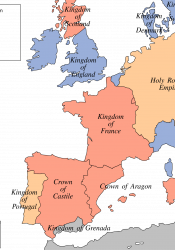Western Schism (Papal Schism)
In 1377, under the leadership of Pope Gregory XI, the Western Roman Church saw the return of the papacy to Rome. This transition marked a temporary end to the reign of the papacy in Avignon, where materialism and corruption had taken root, ostracizing many who practiced Western Christianity. After the death of Gregory XI, political tensions rose as the election of a Neapolitan pope (Urban VI) caused conflict that resulted in the election of a series of antipopes, who served as rival claimants to the papacy. Conflict among the leaders of the Church escalated rapidly, creating political divides that forced secular European leaders to align themselves with either the Roman or Avignonese papal claimant. Rivalries among Catholic factions throughout Western Europe preserved the Western Schism for several decades, until the Council of Constance resolved the conflict in 1418.
(Image Source: Unknown [CC BY-SA 3.0 or GFDL], via Wikimedia Commons, https://commons.wikimedia.org/w/index.php?curid=11502296)

